Table of Contents
ToggleIntroduction
The XP333-R is IWill's second mainboard using the ALi MAGiK 1 chipset. The big difference to the older KA266-R is, that IWill's XP333-R already uses the revised C1 stepping of the ALi MAGiK 1 chipset. The PCB was completely redesigned and faster DDR333 memory is now officially supported - but only at FSB166 speeds. Asynchronous FSB/MEM speeds are not supported.
This is a standout feature among “the first wave” of socket A DDR chipsets, as other chipsets do not offer a divider for AGP and PCI, that ensure that they are operated at 66 or 33 MHz, respectively. But the IWill XP333-R does not only offer a 1/5 divider for FSB166 operation, but also a 1/6 divider for FSB speeds of 200 MHz while keeping PCI and AGP speed at stock 33 / 66 MHz speeds.
Furthermore, IWill integrated loads of tweaking options into the BIOS and added a Highpoint ATA133 RAID controller to the XP333-R's feature-list.
Let's see how IWills rare and forgotten ALi MAGiK flagship board fares in our review.
Specifications and Features
Chipset:
- ALi M1647 Northbridge Rev.C1 [MAGiK 1]
- ALi M1535D+ Southbridge [MAGiK 1]
CPU Support (with latest BIOS):
- Athlon Thunderbird (ALL)
- Athlon XP Palomino (ALL)
- Athlon XP Thoroughbred (all FSB266 models up to 2400+)
- Duron Spitfire (ALL)
- Duron Morgan (ALL)
Memory Support:
- 3 DDR DIMM slots, up to 3GB total
- Official support for DDR333
Expansion Slots:
- 1x AGP slot (1,5 / 3,3V) up to 4x
- 5x PCI slots
Connectors (internal):
- 2x IDE (UDMA133)
- 2x IDE RAID (UDMA133)
- 1x Floppy
- 1x USB 1.1
- 3x 3-pin fan connectors total (1x CPU, 1x chipset, 1x chassis)
Connectors (external):
- 2x PS/2
- 2x COM/RS-232
- 1x Parallel Port
- 2x USB 1.1
- 3x 3,5" Audio Jacks (Line-Out, Line-In, Mic)
- Gameport
You might have noticed, that I didn't mention the audio chipset specifically, as I think far better solutions than the old onboard chipsets are readily available for little money. Very commonly recommended are the Creative Soundblaster Live! cards for example, which offer fantastic compatibility with our beloved old games and sound far better than any onboard solution of that era.
I also don't list (from a retro-gamers perspective) useless connectors and features like IR, Smartcard- or Wake-on-LAN connectors and so on.
Overclocking Features:
- Adjustable Multiplier (BIOS) from x5 to x15
- Adjustable FSB (BIOS) from 100 to 233 MHz in 1 MHz steps
- Adjustable VCore (BIOS) from 1,125 V to 1,850 V in 0,025 V steps
- Additional “+10%” VCore Option (BIOS)
- PCI Dividers (BIOS): CPU/3, CPU/4, CPU/5, CPU/6
- AT Bus Dividers (BIOS): 7,16MHz, CLK2/2, CLK2/3, CLK2/4, CLK2/5, CLK2/6
- I/O Voltage (Jumper): 2,50 V / 2,60 V / 2,70 V
Documentation, Downloads, Drivers
The IWill website went down back in 2007 when the company closed doors. IWill was a rather small manufacturer and (especially in europe) not as widely known as other brands like Asus, EpoX, Abit and so on. Because of that, it is a lot harder to find information, BIOS downloads and CPU support lists for their mainboards nowadays.
The easiest of tasks among these is to find the manual. There are many websites that offer manuals for next to every motherboard in existence. Here are two links to the XP333-R's user manual:
https://www.manualslib.com/manual/1052387/Iwill-Xp333.html
https://manualzz.com/doc/7250467/iwill-xp333-r-user-manual
The manual itself is not especially helpful apart from looking up jumper settings or pin assignments for the frontpanel connector, for example. The explanation of BIOS settings is very basic and incomplete, the information on technical specifications is outdated and/or wrong in many cases.
Two examples:
- The onboard and RAID IDE channels are listed as ATA100, but are both ATA133
- Under “Expansion Slot, Sockets and Connectors”, they list “Two Socket370 sockets” (WTF?) and “One AGP Pro slot”
These are only two examples of many that I found, without reading every single word. The whole manual is done in a very sloppy way.
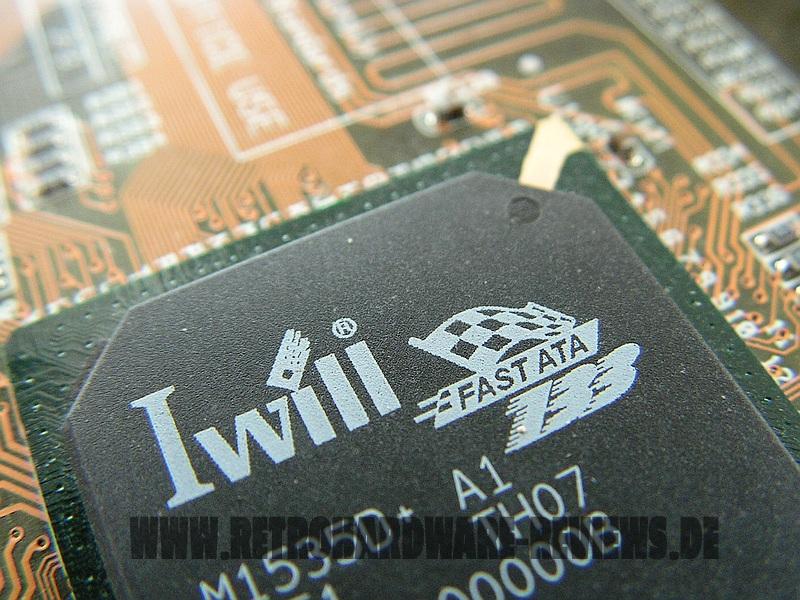
Manual vs. Reality: ATA133
While researching information, I found a cool site with some information on this board, as well as downloads for the manual, some BIOS files (including the most recent from December of 2002) and the ALi/ULi integrated driver:
https://www.ultimateretro.net/de/motherboards/8857
You'll still have to look up drivers for audio and the Highpoint RAID controller (if you plan to use them), but drivers for these are easy to find, as these chips were commonly used on mainboards of that era.
A much bigger issue is to locate a CPU support list for the XP333-R - I was not able to find one.
So let's do some puzzling.
We have a maximum configurable multiplier of x15 and we have the latest BIOS dating to 2002-12.
AMD released the latest Athlon XP T-Bred B model in 2002-11, which was the 2600+ FSB333 model. The 2700+ and 2800+ models were introduced one month earlier. I think all these models *should* work, since the XP333-R offers a FSB/5 divider for PCI and is definitely able to run at these FSB speeds (reviews from its release and personal experience prove that). The XP 2400+ with FSB266 should also work, since its multiplier of x15 is selectable in the BIOS. The XP 2600+ FSB266 model has a multiplier of x16 and might not run, that is something to be tested.
Like in so many cases, reality proves to be different. I couldn't get any of my Athlon XP T-Breds to post. I tried a T-Bred B 2400+ and a T-Bred A 1800+ and both wouldn't post, there was not even a beep code. Then I tried some Athlon XPs with Barton Core and interestingly, all of them posted right away and got a healthy 1,65V VCore assigned. They get reported as “Unknown CPU”, but run fine, even with the FSB set to 166 MHz. The only downside is, that the multiplier of Athlon XP-m CPUs cannot be adjusted. I tested an Athlon XP-m 2500+ and an 2600+ - they both post with a multiplier of x11. If I change the multiplier, the system does not post anymore and I have to reset the BIOS.
I did a short test with a Barton @ 1815 MHz (11 x 166) and got a 50% higher score in 3DMark 99 compared to the Thunderbird C @ 1200 MHz. This is definitely no guarantee that Bartons work without any issues in the long run, but nevertheless a cool thing.
Please note, that all newer Athlon XPs (Thorton, Barton) were released after the release of the latest BIOS version and are definitely not “officially supported”. The same goes for the Duron Applebred, which was introduced in 2003-08.
Design & Layout
OK let's get the elephant out of the room right at the beginning: The position of the ATX power connector is among the worst I have ever seen. And this is not only due to its location on the board alone, but because how close it is to the external audio/gameport connector.
If your fingers are just a little thicker than a child's finger, you'll get into some serious trouble removing the ATX plug from the connector. Since the closing mechanism of the plug is oriented towards the gameport/audio connector, you have to squeeze your finger into this narrow gap to release it.
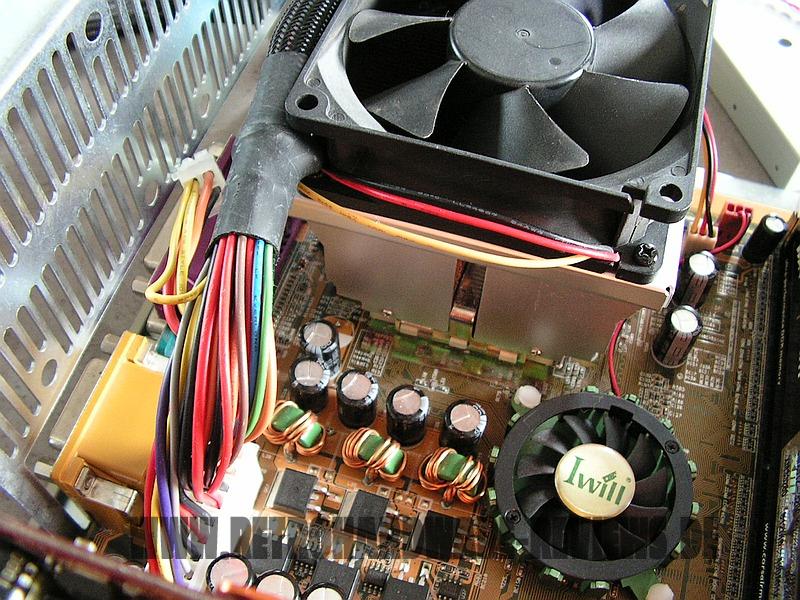
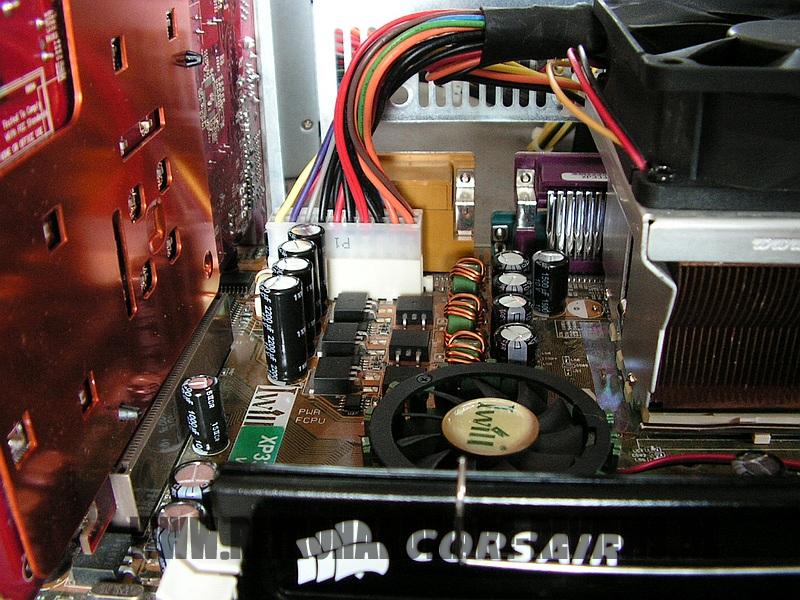
The next issue with this is, that the CPU socket is located relatively close to the top edge of the PCB, so the space between the PSU (if it sits directly above the mainboard inside the case) and the CPU cooler is very small. Depending on which cooler you use and how close the PSU is to the mainboard, you might not be able to route the power cable above the CPU socket, but below, where it seriously affects the airflow in the system.
The CPU socket itself offers a lot of space around it, so that most coolers should fit, regardless of their size. To put this to a test, I checked the following eight CPU cooler towards compatibility:
- Thermaltake Silent Boost K7
- Cooler Master HHC-001
- Swiftech MCX 370
- Alpha PAL 6035
- Alpha PAL 8045
- Smartcooler 60mm
- Arctic Cooling Copper Lite
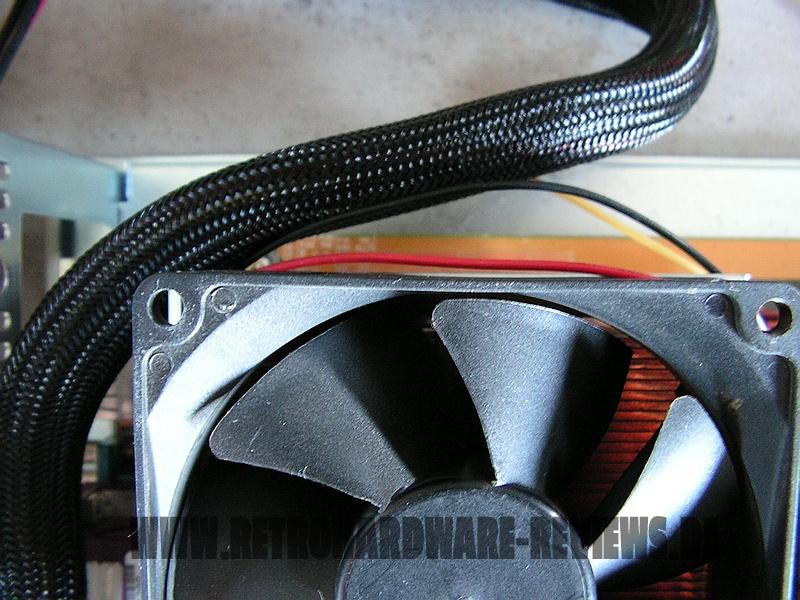
All of these were easy to install and do not collide with anything around the CPU socket. The Cooler Master HHC-001 however, like on many mainboards, reaches a bit over the top edge of the PCB with the lever of its mounting mechanism. It is a bit less than on most Abit boards for expample, but still too much to fit it in, when you have a case with the PSU installed directly above the mainboard.
To protect the PCB from screwdriver hits while mounting a CPU cooler, IWill installed two thick plastic stripes around the CPU socket. On my XP333-R, it seems like this protection paid off at least once, when looking at the stripe above the CPU socket.

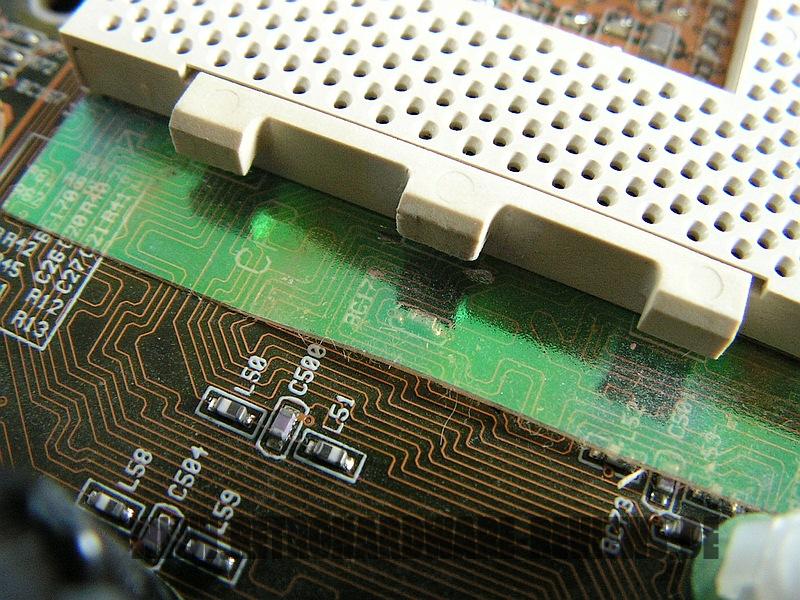
There are of course also some positive things to mention regarding the layout. The position of the IDE and IDE-RAID connectors is perfect, for example. The ribbon cables can be routed away from the PCB easily, because the connectors are located directly at the right edge of the PCB.
The floppy connector is placed pretty far towards the lower right edge of the PCB, which seems rather bad first. But fortunately, there are no important connectors or jumpers beneath it, so it is no problem to route the floppy cable down and then up again on the backside of the board.
Because IWill included only five PCI slots on the XP333-R, the AGP slot is located a bit lower. This leaves enough space between the AGP card and the memory slots, so that memory sticks can be removed and installed while your videocard stays in place.
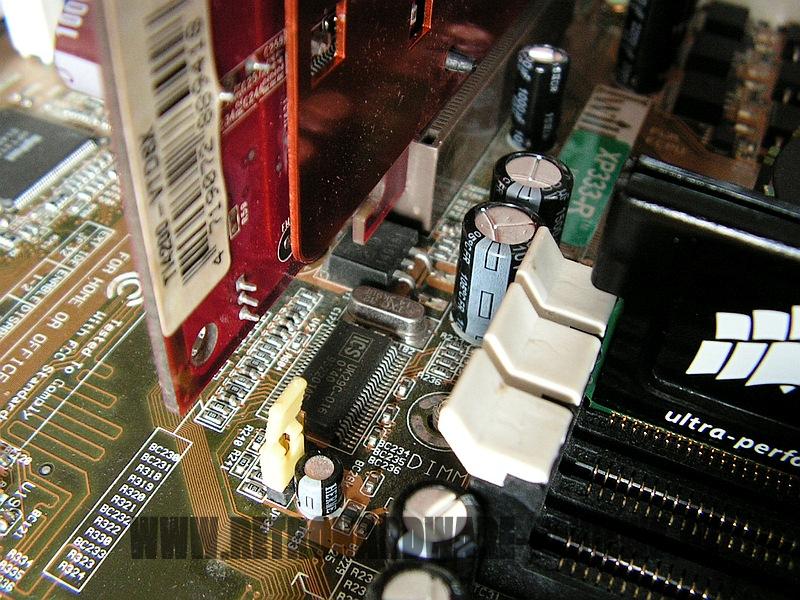

What I don't like about the XP333-R, is the lack of information on jumper settings printed onto the PCB. For example, there are jumpers to disable the onboard RAID- and audio chips and there are tables, that explain which jumper setting en- or disables them. But, on the other hand, there are no tables to be found for the FSB, VIO or even the CMOS jumpers.
I also don't understand, why the FSB jumper exists anyway. FSB and PCI/AGP dividers are configurable from within the BIOS and the jumper only selects, if the board powers up with FSB100 or FSB133. You can configure the FSB in 1 MHz steps from 100 to 233, regardless of how the jumper is set. All PCI/AGP dividers are available at both settings, too.
Another negative aspect is, that the imprint for the frontpanel connector assignment is not readable for all pins. You can identify the pins for power-on, power LED and speaker, but in order to connect the reset button or the HDD LED, you have to look it up in the manual.
The last thing I'd like to mention, is the fan header “situation”. There are three 3-pin fan headers, but one is already in use by the chipset fan and one is of course for the CPU fan. So you can only connect a single casefan on the connector located on the lower right edge of the PCB. This is insufficient in my opinion, especially taking into account that the XP333-R was a flagship model in IWill's product lineup.
Test-System and Parts
Baseline Setup:
- CPU: AMD Athlon Thunderbird 1200C (FSB133)
Because I want to compare 1st Gen Socket A mainboards to their DDR follow-ups I have to use a CPU, which is available in FSB100 and FSB133 versions with the same clockspeed. Since I sadly don't have a Thunderbird 1400 B at my disposal, I will use the Thunderbird 1200 for my reviews and comparisons of these boards, which I have in the “B” (FSB100) and “C” (FSB133) version.
- RAM: 1x Corsair CMX512-3200C2 (XMS3202v4.2) = 512MB PC400 CL2
This Corsair XMS stick should allow the tightest timings at 266 MHz DDR and its size of 512MB is the perfect choice for Windows 98SE.
- VGA: MSI Geforce 4 TI4200-VTD8X
To remove any GPU bottleneck for testing, I chose a Geforce 4 Ti as the primary graphics card for my test setups. The Geforce 4 Ti series are also known to pull a lot of power from the AGP port, so that possible problems in that department can also be revealed. It is also somewhat period correct and a good match for a high performance retro-machine that should be able to run late Windows 98SE games without any issues.
- VGA2: 3dfx Voodoo 5 5500 AGP
Many people consider the Voodoo 5 5500 the perfect card for (Win9x-) retro gaming. The Voodoo 5 benefits from a beefy setup, so a powerful Athlon Thunderbird or early Athlon XP is the perfect match for this card.
- Audio: Creative Soundblaster Live! (SB0060)
Creative's Soundblaster Live! can be found in many retro-machines. It offers great sound, perfect Win98SE compatibility and is still widely available for reasonable money. It was also known to cause problems with VIA-based 686B southbridges using old BIOS revisions and VIA chipset drivers. All this should be history at this point, but double checking on pontentially affected mainboards is still not a bad thing to do.
- LAN: 3Com Etherlink XL PCI
Just a good, reliable choice for networking. All legacy Windows versions all the way up from Win95 have built-in drivers for it, which is also a huge “plus”.
- HDD: Western Digital WD200BB (20GB 7200RPM)
No special intention behind this drive, it is just “there” and still works fine.
Additional Hardware for certain Tests:
- Silicon Image Sil3512 SATA Controller & Samsung PM871 128GB SSD
These two will help me measure the PCI bandwidth.
- Hitachi Deskstar T7K500 (500GB 7200RPM)
This drive will tell us, how big we can go with the onboard IDE connectors and how the performance is like.
- 2x Voodoo 2 12MB (SLI)
A pair of Voodoo 2s is a must have for any retro-machine, that doesn't feature a 3dfx card as the primary VGA solution. They offer compatibility to older Glide games and can be used with any more powerful primary graphics card. It is an important thing to know, how well these perform and if there are differences between all the available Socket A chipsets of that era or even between boards using the same chipset.
Drivers used:
- Chipset: ALi AGP v1.82e
- Geforce 4: nVidia Forceware 43.45
- Voodoo 5: Amigamerlin 2.9
- Voodoo 2: FastVoodoo 4.6
- SB Live!: Some driver from my archive, not shure 😉
- 3Com NIC: Windows 98SE preloaded driver
- SATA Controller: Some driver from my archive, not shure 😉
System Setup and Usage
The installation of the CPU and memory was pretty straightforward. I just installed both, went into the BIOS and set every memory timing to the fastest option, which is:
- DRAM CAS Select: 2
- DRAM Performance: Ultra2
- DRAM Read Enhance: Enable
- DRAM WBUF Flush: Enable
- RAM BIU Output Bypass Mode: Enable
- RAM BIU Input Bypass Mode: CAS2
This resulted in a DDR266 CL2 2-2-4 memory configuration and proved to be stable throughout all testing. The next step was the Installation of the expansion cards. Because I din't find any information on INT routing and IRQ sharing, I started with some testing in that direction. First, I booted the system with all onboard components enabled, to see which IRQ are assigned to which device by default. Which looked like this:
- IRQ 5: Onboard Audio
- IRQ 9: ACPI
- IRQ 10: VGA
- IRQ 11: Onboard Highpoint RAID + USB
- IRQ 14/15: IDE
Then, I plugged in my 3Com NIC into all PCI slots starting from PCI#1 up to PCI#5 to see, where IRQs get shared. This is the result:
- PCI#1 and PCI#5 share the same INT line
- The USB controller is also on the same INT line as PCI#1 and PCI#5
- PCI#2 is shared with the Highpoint RAID controller
- PCI#3 is shared with the onboard audio
- PCI#4 is shared with the AGP port
Next, I disabled unnecessary onboard components like the serial ports, LPT, floppy controller as well as onboard audio and RAID. Then I installed my expansion cards as follows:
- PCI#1: free
- PCI#2: Soundblaster Live!
- PCI#3: Voodoo 2
- PCI#4: Voodoo 2
- PCI#5: 3Com NIC
With this configuration, all devices got their own IRQ, with only the USB controller and the 3Com NIC sharing the same interrupt. The installation of all software and drivers completed without issues, but the SB16 Emulation device of the Soundblaster Live! got IRQ9 assigned, which is bad for DOS games compatibility. I also couldn't assign IRQ 5 or 7 manually, because they were in use.
So I went into the BIOS, to see if there is an option to reserve a specific IRQ. And this was the case - under PNP/PCI Configurations - Ressources controlled by, I changed the option to Manual, then changed the value of IRQ7 to Legacy/ISA. This did the trick, now I was able to manually change the IRQ of the SB16 emulation device to 7 in the device manager.
All of the following tests and benchmarks completed without technical issues ..but.. ..well.. we'll discuss the performance details later in this review.
After I was done with the Geforce 4 and Voodoo 2 benchmarking, I removed these cards and swapped in the Voodoo 5 as well as the SATA controller, which I installed into PCI#3. The first reboot after the installation of these two cards yielded a black screen with a blinking cursor (even before the Win98 boot screen would show up), but after a reset, the system booted fine and both cards were operational. No further hick-ups occurred during the subsequent tests, this is also true for the benchmarking of the Highpoint RAID controller (for which I of course put the SB Live! into PCI#3 to avoid IRQ sharing).
An interesting feature of the XP333-R is the official support for FSB333. So why waste performance, let's spank that Thunderbird! Fortunately, my Athlon 1200 C is unlocked, so I can lower the multiplier, to 7x to raise the FSB all the way to 172 MHz. This results in 1204 MHz (1202,8 real) and also overclocks PCI and AGP a tiny little. I had to adjust the dividers for PCI and AT Bus, as well as the memory timings to CL2 2-2-6. The changed settings in detail:
- DRAM CAS Select: 2
- DRAM Performance: Fast
- DRAM Read Enhance:: Enable
- DRAM WBUF Flush: Enable
- RAM BIU Output Bypass Mode: Enable
- RAM BIU Input Bypass Mode: CAS2
- AT Bus Clock: CLK2/5
- PCI Clock Divider: CPU/5
The system ran flawlessly with the higher FSB set and showed a nice performance boost, which we will see in the next part of the review.
After my regular testing, I tried to shed some light on the CPU support situation. I already wrote a little on that topic in the “Documentation” section earlier in this review, and since extended OC experiments are not a part of my regular reviewing, I won't go into too much detail. But I want to briefly mention, that I also tried to boot with the FSB configured to 200 MHz and the CPU/6 divider set.
I got a POST with my Athlon XP-m Barton at 11x200 MHz, but the system froze during the initial memory test. This was with DRAM performance set to Normal and no other options changed, including voltages. I am shure there is a way to have this board running at FSB200, but since the Barton Core is officially unsupported and the board didn't want to work with my Thoroughbred Athlon XPs (which it should), there would be to many variables for testing and thus too much time to invest, at least for now.
Perhaps I'll feature the XP333-R again some time later and do an in-depth OC review / test. Maybe if a have some more T-Breds and Bartons at my disposal.
Benchmarks
Synthetic Measurements
Before we get into the 3DMark and gaming benchmarks, let's have a look at some theoretical numbers. These synthetic tests will exhibit the differences between the several chipsets and boards better than any game benchmark and provide us with "background information" that might be of use in understanding the timedemo results later.
Memory Performance: AIDA64 Cache & Memory Benchmark
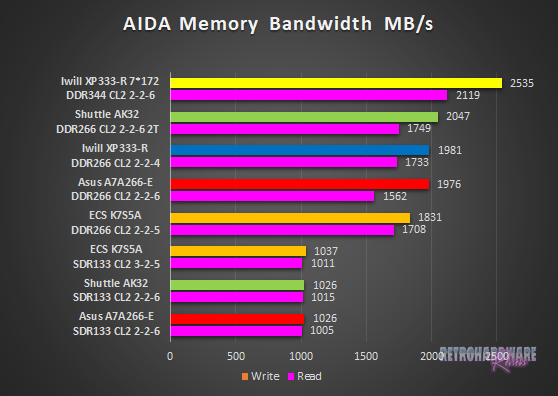
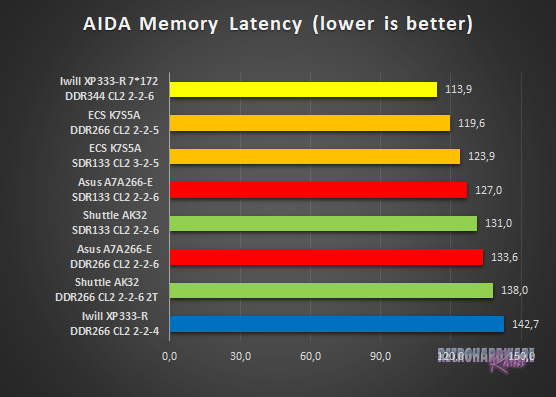
The XP333-R's memory performance looks very good. Even though it operates at a rather low stock FSB of 132,66 MHz, resulting in only 1194 MHz CPU clock, the Shuttle AK32 with the VIA KT266 chipset is not far ahead. It also shows much better performance (at least in terms of read throughput) than the Asus A7A266-E, which is also based on the ALi chipset.
The board's result for FSB172 finally, is miles ahead of the competition.
In the memory latency test, the board's slightly underclocked FSB takes its toll an the IWill board ranks last for the FSB133 run. The higher FSB of 172 MHz, however, helps dramatically and the XP333-R is able to take the lead.
Application Performance: 7-Zip
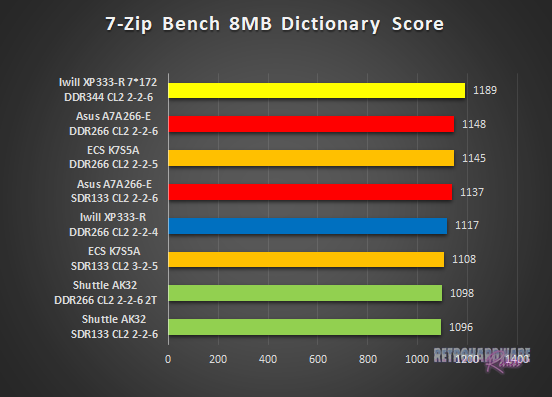
The low CPU clock is a huge problem in the 7-Zip benchmark. The IWill board doesn't look too good here in the FSB133 run and get's surpassed by the A7A266-E, with both SDR and DDR memory. With the higher FSB, it is by far the fastest again.
AGP Performance: Final Reality Benchmark
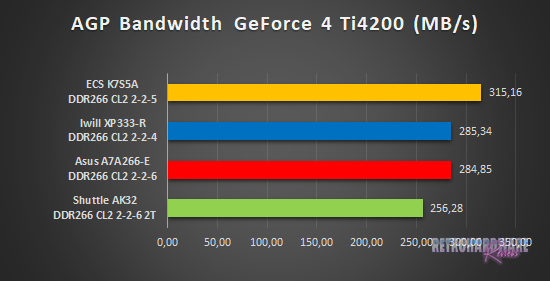
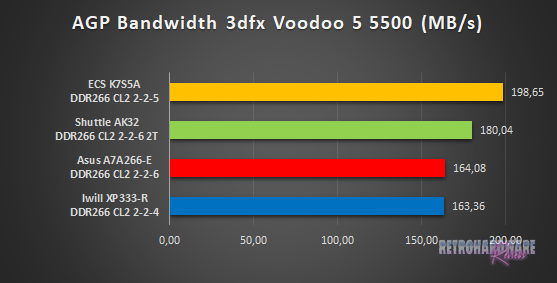
The AGP throughput for both videocards is almost identical to the other ALi board in the test, namely the Asus A7A266-E. The bandwidth for the GeForce 4 Ti looks pretty good and ranks between the very well performing K7S5A and the KT266 based AK32.
The bandwidth for the Voodoo5 looks not particularly good for both ALi boards. We'll see later, if this is a limiting factor in one or more of our 3D(-gaming) benchmarks.
AGP and PCI Performance: 3DMark 2000 and ATTO
3DMark 2000 as a whole is very focused on TnL and is by far not as interesting for retro-hardware comparisons as its predecessor. Its “High Polygon Count, 1 Light” test, however, is another good way to measure the AGP performance. In opposite to the Final Reality test, the general system performance is also somewhat of importance. The benchmark was executed with the Geforce 4 Ti installed.
To measure PCI performance, I installed a Windows 98SE compatible SATA controller with a Samsung PM871 128GB SSD connected into the system. For the bench, I chose 1024 to 4096 KB block size and picked the overall best values for the read and write throughput. This test will show, which maximum performance can be expected with fast storage options like SATA or SCSI and maybe gives a hint, if the chipset might be good for Voodoo 2 cards.
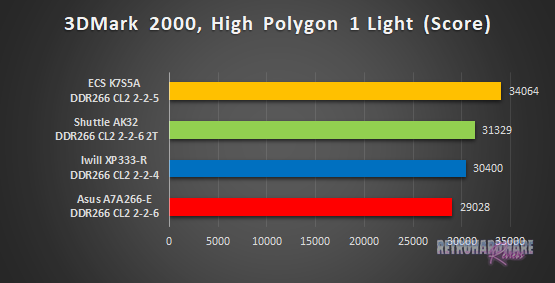
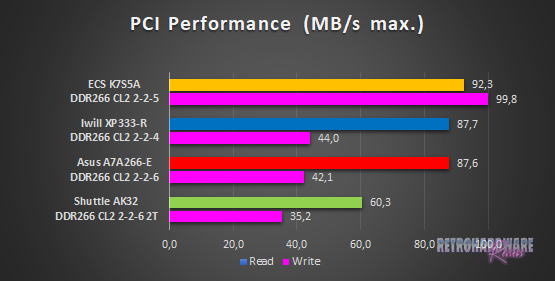
The score for the 3DMark2000 sub-test is more than 10% behind the first-placed ECS K7S5A, the AK32 also scores around 1000 points higher. But at least it is able to beat the A7A266-E, making it the fastest ALi board.
The PCI read throughput in the ATTO test is quite good with just under 88 MB/s The write performance, on the other hand, leaves a lot to be desired. Even though the boards from Shuttle and Asus show even worse performance, 44 MB/s of write throughput is still a very bad result.
Storage Performance: HDTach
To measure the performance of the board's IDE and (if available) onboard IDE RAID solutions' performance, I benched one of the latest and fastest IDE drives (the Hitachi Deskstar T7K500 500GB) with the HDTach benchmark. I also tried a much more “recent” drive (the Western Digital Blue Edition 500GB), which should be even faster in theory, but the Hitachi drive produced much better results in this test.
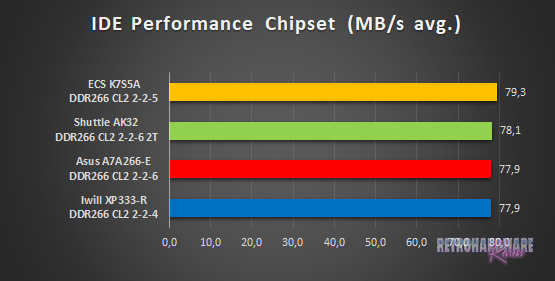
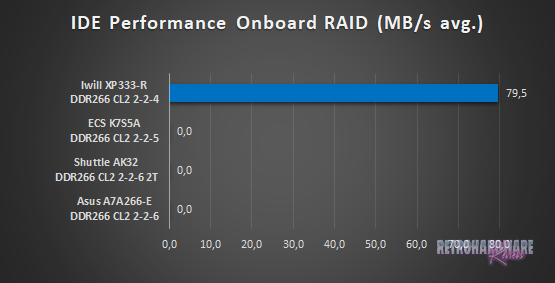
The IDE performance is very close between the boards and generally on a very high level. Both ALi based boards achieve an identical result of 77,9 MB/s and rank third.
The XP333-R is the only board with an additional IDE RAID chipset and achieves 79,5 MB/s in the HDTach benchmark, giving it the fastest IDE based storage option among the boards tested.
Gaming Benchmarks
Now that we got all the theoretical performance numbers, let's see how the contenders perform in 3D gaming benchmarks.
3D Performance: 3DMark99max
3DMark99max was released in early 1999 and comes without support for Hardware TnL. The maximum supported (hardware-) DirectX level is DX6. It is a great benchmark to reveal good overall system performance, as it rewards good memory bandwidth and latency more than the slight clockspeed advantage, that some boards have because of their factory-overclocked FSBs.
- Version: "latest"
- Settings: standard
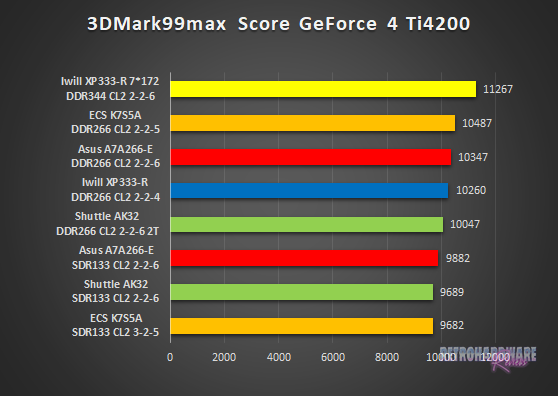
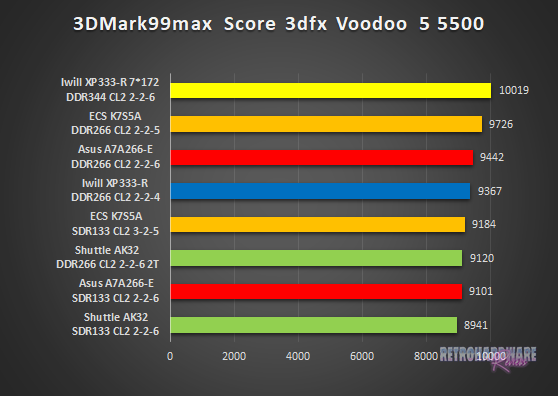
The XP333-R takes fourth place with both graphics cards, both times less than 100 points behind the third-placed A7A266-E. With the higher FSB, the board wins both runs. With the GeForce 4 Ti installed, the increased FSB provides a massive boost in score of almost 10%, and the score with the Voodoo 5 installed also increases by a decent 7%.
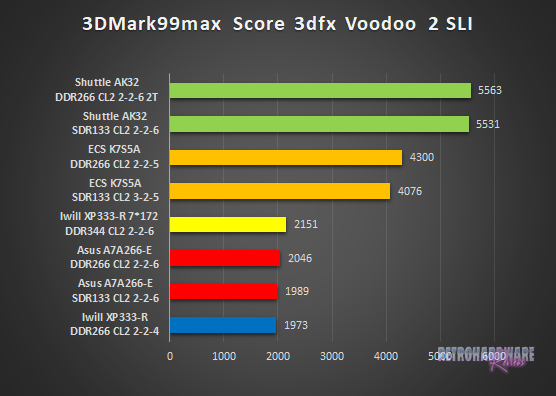
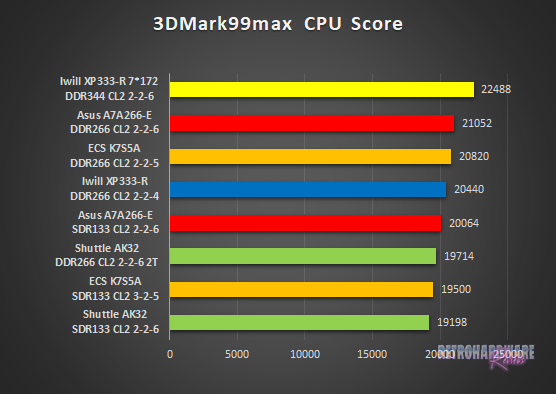
The "performance" in the Voodoo 2 SLI run of 3DMark99max is nothing short of catastrophic, IWill's board ranks last here with a score of less than 2000 points. Obviously the ALi chipset is best not combined with Voodoo 2 cards, since the Asus A7A266-E's performance is equally bad. We'll see in the subsequent UT99 benches, if this problem is limited to D3D games, or if Glide is also affected.
But first, let's have a look at CPU performance in this test. Like with both the GeForce 4 Ti and the Voodoo 5, the board takes fourth place for the 3DMark99max CPU score with FSB133. With the FSB set to 172 MHz, the XP333-R shows by far the best CPU performance in this bench, reaching almost 22500 CPU Marks.
3D Performance: Unreal Tournament (UT99) Timedemo(s)
Unreal Tournament (UT99) was released in November 1999 and is notorious for its hunger for CPU power. I chose to use two different timedemos for comparison, of which the utbench.dem timedemo is heavily CPU bound and therefore qualifies to measure the general performance of the boards. The second timedemo benchmark.dem is as GPU limited as possible in this game. This will reveal, how much impact a faster board can still have in more GPU limited situations. This game is also perfect to show, on which chipsets and boards Voodoo 2 cards run best.
- Version: 4.36
- Settings: High, Min desired Framerate "0", Show Decals [x], Use Dynamic Lightning [x]
- Geforce: D3D
- Voodoo 2 and Voodoo 5: Glide
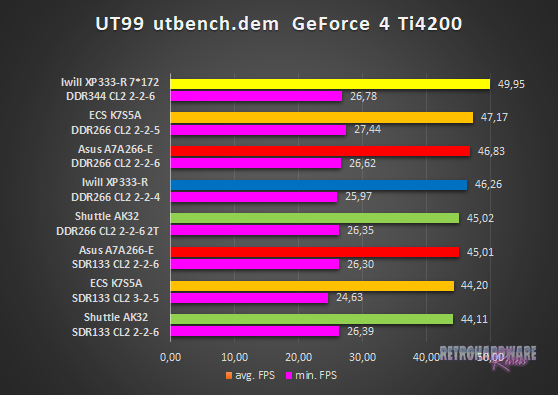
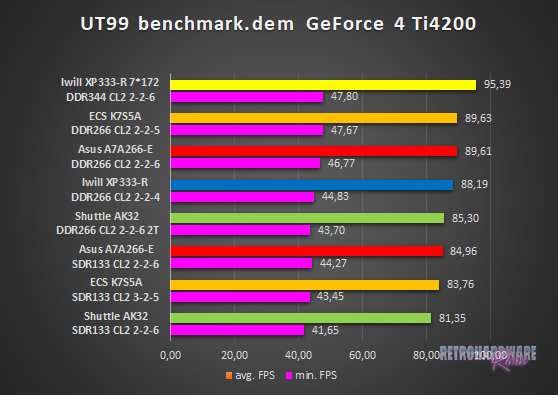
In the CPU-heavy utbench timedemo, the IWill board is disadvantaged again, because of its low CPU clock. Taking this into account, its performance for FSB133 is not too shabby, outperforming the AK32 by more than 1 FPS on average and ranking fourth. The minimum FPS are rather weak though, only the K7S5A with SDR memory achieves less in this respect.
In the second timedemo, it ranks fourth as well. This time, the distance to the third-placed A7A266-E for both average and minimum framerate is bigger than it was in the utbench timedemo. Nevertheless, it still performs considerably better than Shuttle's KT266 board.
With FSB172, the XP333-R is once again unrivaled in both timedemos.
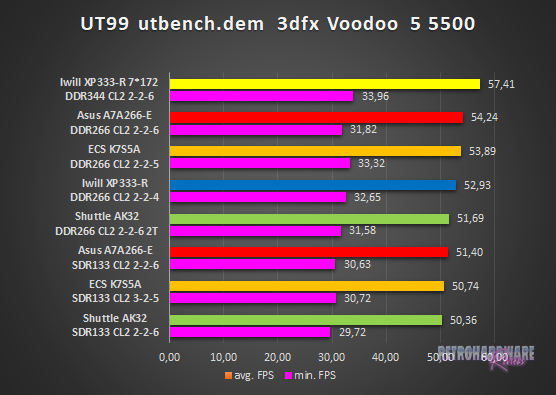
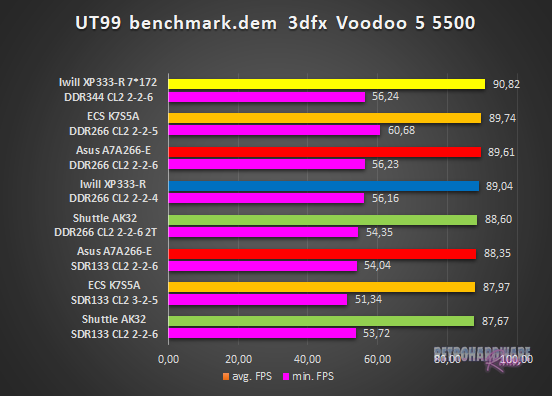
The situation in the utbench timedemo is comparable to what we saw with the nVidia card, but this time the minimum FPS look a lot healthier for the FSB133 run.
In the second timedemo, the results are very close. The IWill board takes fourth place again with stock FSB, but the difference in average FPS is less than 1 FPS to the second- and third-ranked K7S5A and A7A266-E, respectively.
The board gains around 2 FPS on average with the higher FSB, but the minimum FPS remain almost identical and are on the same (good) level of Asus' ALi board. The ECS K7S5A with the SiS735 chipset, however, is unrivaled here, keeping the framerate over 60 FPS at all times.
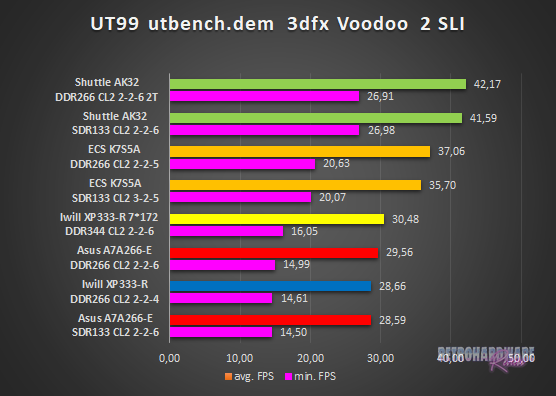
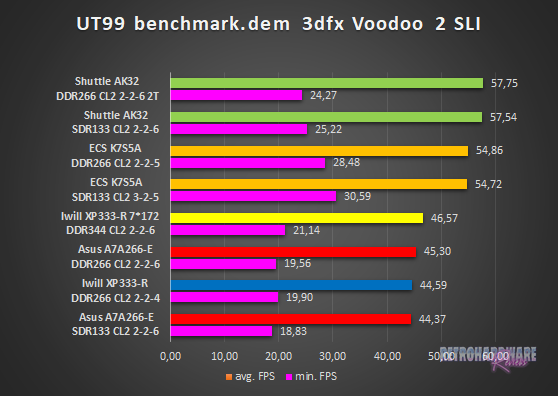
We see the same catastrophic result for the Voodoo 2 cards as in 3DMark99max before - both ALi boards show abysmal performance and battle for last place.
3D Performance: Quake III Arena Timedemo
Quake 3 Arena was released shortly after Unreal Tournament, in December of 1999. It is known to reward fast memory latency and with its normal preset, it is completely CPU limited; at least for the GeForce 4 and the Voodoo 5. The Voodoo 2 SLI cards clearly limit the Athlon 1200 here, as the timedemo will show.
- Version: 1.32
- Settings: “Normal” Preset, only resolution changed to 1024x768x16
- Geforce 5 and Voodoo5: OpenGL
- Voodoo 2: “Voodoo” Renderer (miniGL)
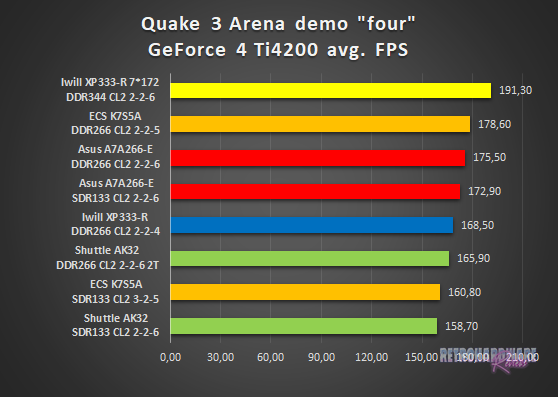
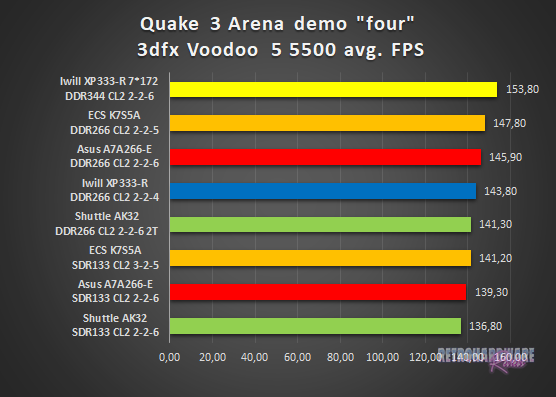
The results for Q3A's GeForce 4 Ti run look quite unpleasant for the XP333-R. It is clearly outperformed by the A7A266-E, even with the latter using the slower SDR memory, and only ranks fifth with the stock FSB of 133 MHz. However, the higher FSB seems to help massively here. The IWill board squeezes another ~23 FPS out of the nVidia card and gains a significant lead over the second-placed K7S5A.
In the Voodoo 5 run, the results are closer. The XP333-R is still slower than the Asus board with DDR memory, but not as much as before. In its FSB172 run, IWill's board takes first place again with 6 FPS ahead of the K7S5A.
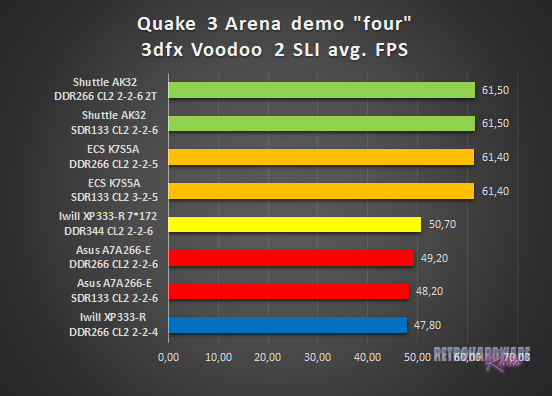
Both ALi boards again show poor performance, far worse than seen from the VIA and SiS chipset-based boards by Shuttle and ECS. The XP333-R again ranks last, behind the A7A266-E in both memory configurations. Performance improves slightly with the higher FSB, but is still in the same (bad) range and only marginally ahead of the Asus board.
Summary & Rating
IWill XP333-R (ALi MAGiK 1)
-
Layout
-
Features
-
Overclocking Options
-
Compatibility
-
Documentation & Support
-
Performance: GeForce 4 Ti 4200
-
Performance: Voodoo 5 5500
-
Performance: Voodoo 2 SLI
OVERALL
Note: The performance rating is based on the FSB172 benchmarks of the board, since the 1/5 divider makes this FSB perfectly usable. With FSB133, the total rating of the board would change to 3.13.
| Pros | Cons |
| + Unmatched variety of overclocking options | – Abysmal Voodoo 2 performance |
| + Fantastic Voodoo 5 and Geforce 4 performance | – Abysmal documentation (on PCB and in manual) |
| + Very good IDE & IDE RAID chip performance | – Rather bad PCI performance |
| – ATX connector position |





